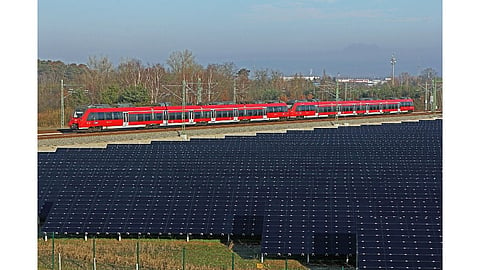

Deutsche Bahn could install 37.6 GW of solar along its rail network, producing 32,920 GWh/year, according to a Fraunhofer ISE research
While PV systems up to 5 MW can feed directly into its private grid, larger systems need substations or transformers
The research team finds that regulatory and technical requirements currently limit the direct feeding of solar power into its network
Germany’s national railway operator, Deutsche Bahn (DB), could install up to 37.6 GW of solar power along its rail network, a study by the Fraunhofer Institute for Solar Energy Systems ISE has found. This could produce about 32,920 GWh of electricity each year – several times more than the power it used for train operations in 2023 (7,500 GWh).
Its current generation facilities of nearly 2 GW comprise conventional power plants and hydroelectric facilities. Yet, it does not have PV systems that directly feed power into the traction power grid.
DB, the largest electricity consumer in the country, has its own power grid spanning nearly 8,000 kms. As part of itsPV4Rail project, Fraunhofer ISE studied this power grid to explore the potential for direct feeding of solar power.
“However, a significant portion of the energy demand in the traction power grid could be covered by photovoltaics, because the potential for PV areas along railway lines is many times higher than the amount of energy consumed in the traction power grid,” said PV4Rail project manager at Fraunhofer ISE, Andreas Hensel.
The Fraunhofer ISE team identified suitable sites across Germany and examined their potential using detailed simulations using a 2 MW central inverter developed by project partner Vensys Elektrotechnik GmbH, which was divided into 2 symmetrical power units of 1 MW each for the purpose. According to its estimates, there exists 37.6 GW of potential PV capacity in areas within a 2-km radius of a railway substation alone within the network’s single-phase frequency of 16.7 Hz.
According to its simulations, PV systems with up to 5 MW installed capacity can directly feed into the network’s overhead line. Those with up to 12 MW capacity will need busbars to feed into substations. Larger systems up to 40 MW will require a separate substation with a transformer and switchgear to integrate into the 110 kV network.
While Germany’s neighbor, Austria, has several operational traction PV systems of over 10 MW capacity, Fraunhofer ISE says DB’s grid connection requirements differ from those of Austria’s ÖBB. DB can only integrate voltage-impressing inverters to ensure compatibility with its control and signaling systems.
Fraunhofer ISE researchers note that traction grid-connected solar systems could play an important role in Germany’s energy transition if regulatory and market hurdles are removed.
